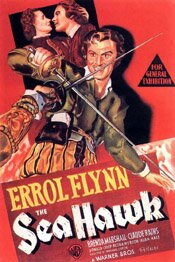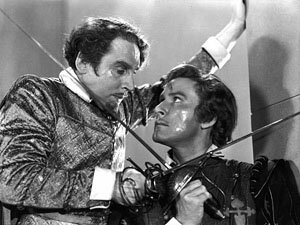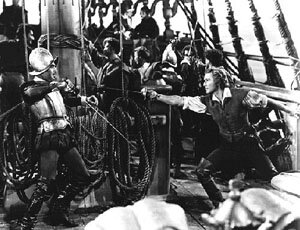No snide comment is implied by “Errol Flynn … gains some gravity,” though by the time this movie was made the older Flynn had put on a few pounds. Rather, his performance has a bit of weight that wasn’t there in the younger Flynn’s roles. You can see it in this movie, The Master of Ballantrae, though I don’t think anyone would rate the movie itself terribly high.
The impish Errol Flynn in a swashbuckler
A few years ago I bought a fistful of Errol Flynn movies that were in one of those many Warner Brothers collections. I had only vague memories of Flynn movies but was curious having seen The Adventures of Robin Hood and, a few years earlier, having read his autobiography, My Wicked, Wicked Ways (recommended, by the way — it is so much fun to read).
Among the movies in the collection was the one I scribbled about below, The Sea Hawk. Interestingly, just as Robin Hood was directed (in part) by Michael Curtiz, he also directs this movie. He seems to have been aware of what Flynn brought to these movies and was very good at getting it.
 The Sea Hawk (1940)
The Sea Hawk (1940)
Directed by Michael Curtiz
I’m halfway through Errol Flynn: The Signature Collection and I think I’ve hit the real gem of the lot. (Not that the others aren’t good too.) It’s The Sea Hawk and it really does put the “swash” in swashbuckler.
It’s absolutely brilliant and in a number of respects. I can’t help comparing it to The Adventures of Robin Hood. It has much of the same feel while at the same time has a little something different.
For one thing, both films capture a sense of fun and exuberance. Both also manage to be rousing costume adventures without any sense of self-consciousness though The Sea Hawk differs slightly in that Errol Flynn plays the British pirate Captain Geoffrey Thorpe with a kind of very contained impishness.
His captain is apparently quite serious, patriotic and heroic, yet every now and then he seems to be restraining a smile or grin.

As someone in the special feature on the DVD says (The Sea Hawk: Flynn in Action), it’s almost as if Flynn is asking the audience, “Are you really buying this?”
But in these Flynn movies this kind of feeling is not one of mocking the audience but of having fun with them. Flynn seems to play his swashbuckling roles the way the early Springsteen played concerts – the more fun the audience had, the more fun he had and together they create a kind of synergistic relationship.
Another fascinating way in which The Adventures of Robin Hood and The Sea Hawk compare is in their look. Where Robin Hood is an incredibly exuberant display of colour, The Sea Hawk is nothing less than a magnificent example of black and white. (Although I could have done without the Panama scenes done in sepia.)
The sea battles between the ships are fabulous.

We know from recent films like Master and Commander that great sea battles can be done in colour but I’ll take The Sea Hawk’s scenes anytime. (It’s also incredible to think these were done on sets.)
There is also a great sword fight (as there must be to conclude an Errol Flynn swashbuckler) where, again, the black and white scenes with their use of light and shadow are exceptional. I loved the great shadows on the walls during the struggle.
The Sea Hawk is about as close to the quintessential swashbuckler as you can get. It has Errol Flynn, the man who pretty much defines the hero of such movies.
It has the great set pieces like the sea battles and the swordfights. And it has the music that has influenced the sound of almost all heroic adventures.
Credit for the music goes to Erich Wolfgang Korngold. His score (which is apparently not just rousing but quite clever as it uses, in part, themes from the earlier The Private Lives of Elizabeth and Essex but in a reworked form), is operatic which, if you think about it, is really what such romantic adventures require.
I really didn’t know a great deal about The Sea Hawk before watching it. And to be honest, I wasn’t expecting a great deal. I basically put it in the DVD player because I wanted to watch something and I hadn’t seen this one yet.
As often happens, when I was least expecting it, I encountered a wonderful movie. Highly recommended.
(The Sea Hawk also aired last night on TCM. I missed it but I may watch my copy again tonight. The above was written roughly about April 2005.)
Movies, books and upkeep
I guess you could say I did a bit of house-cleaning with my blogs today – a sisyphean task to complete, but I gave it a go.
Although Piddleville continues to be an organizational mess, I made a few changes – temporary ones, I hope. (It needs some fixing). One was to create a “book review” section because I have a few movie related book reviews here and there. I added two today (yes, a very small start):
My Wicked, Wicked Ways – the Errol Flynn autobiography from 1959, and a wildly entertaining read.
The combustible Ava Gardner – the Ava Gardner: ‘Love is Nothing’ biography by Lee Server from a few years ago, also tremendously entertaining.
I don’t do a lot of book reviews but when I do it’s usually because I really enjoy the book, as was the case with both of these.
While I was at it, I also added a brief (and sadly lacking) review of one of my favourite movies, The Night of the Iguana (1964).
My Wicked, Wicked Ways – review
The Autobiography of Errol Flynn (1959)
by Errol Flynn
I just finished reading, and thoroughly enjoyed, My Wicked, Wicked Ways: The Autobiography of Errol Flynn, originally published somewhere around 1959, available now through Cooper Square Press (part of Taylor Trade Publishing group).
Heavens, what a helluva good read. Is anything he says true? Well, maybe. Probably, at least some of it. But that’s not really the point, not for me.
It reads as if it’s the transcript of a recording of a great raconteur, a teller of tall-tales whose favourite tale is his own life. You get the sense of a man who is totally self-absorbed but, somehow, has such a winning personality you love him for it.
I originally picked up the book because I was interested in finding a unique character I might make use of in a story, a model for a supporting player. I had a vague notion that Errol Flynn might have some of the qualities I was looking for.
Well, geez … did I ever get my money’s worth in Flynn. It’s not simply a matter of a long, episodic tale of the picaresque variety, but also one of style. The words, syntax … everything that goes into creating a “voice” in writing, is here.
It’s the breezy voice of a kid who never grew up. In its conclusion, it’s also the voice of a kid who doesn’t quite understand how or why his life has gone the way it has.
For me, the incidents are less important than the personality that comes across (although the incidents are quite remarkable). Together, personality and incidents, it makes for an incredibly entertaining book.
The breezy tone of the adventures carries through for roughly the first two thirds of the book. The fantastic, tall-tale quality is richest as Flynn recounts his early life and his various adventures as he travelled the world, especially Tasmania, Australia and the south seas.
His accounts of his Hollywood life are equally entertaining while also being salacious and gossipy. The raconteur quality comes forth through what the book relates and how Flynn relates it.
Although the book overall is chronological, he bounces back and forth in time. This almost mimicks on the page the way someone tells a story orally as one thought prompts another.
Sometimes the jumps in time and subject are almost non-sequiters. Yet it never seems excessive or sloppy, simply stylisticly casual.
As the book winds down you get the sense Flynn is winding down. It’s almost as if he becomes disinterested. There’s a melancholy quality to the book as he becomes increasingly reflective.
While Flynn’s most winning quality seems to be a boyish charm, as the book progresses the negative side of that charm is immaturity. It’s this that seems to catch up to Flynn in the end.
Finally, the man at the end of the book comes across as one who is close to but not yet quite grasping the meaning of his life (pompous as that may sound). Or, to put it another way, time seems to catch up to Flynn. Age. The image we end up with is of a somewhat faded Hollywood star, alone at his beautiful Jamaican home, not entirely sure what remains of his life or what to do with what remains.
As the Wikipedia entry on Errol Flynn says, “By the mid 1950s, Flynn was something of a self-parody: heavy alcohol abuse left him noticeably bloated in his last years.” He died of heart failure in Vancouver a short time before this book came out.
Knowing something of the final years of Flynn’s life amplifies the melancholy of the book’s conclusion for the reader and makes its final line resonate in a sad way.
However, while this may be how it winds down it is certainly not the tone of the majority of the book. It is flush with a sense of fun and adventure and humour.
Flynn is a character, in the truest sense. He’s marvellous and if I had known him, I don’t think I would have trusted him any further than I could throw him.
(By the way, it sounds as if the writing of My Wicked, Wicked Ways was a great story too, or so the book’s introduction suggests. As another aside, Flynn originally wanted to call the book, In Like Me, as a play on the popular phrase, “In like Flynn,” a line that came about due to one of the episodes in his life.)
Originally posted in 2005 (or earlier).
My Wicked, Wicked Ways:
– Amazon.com
– Amazon.ca


